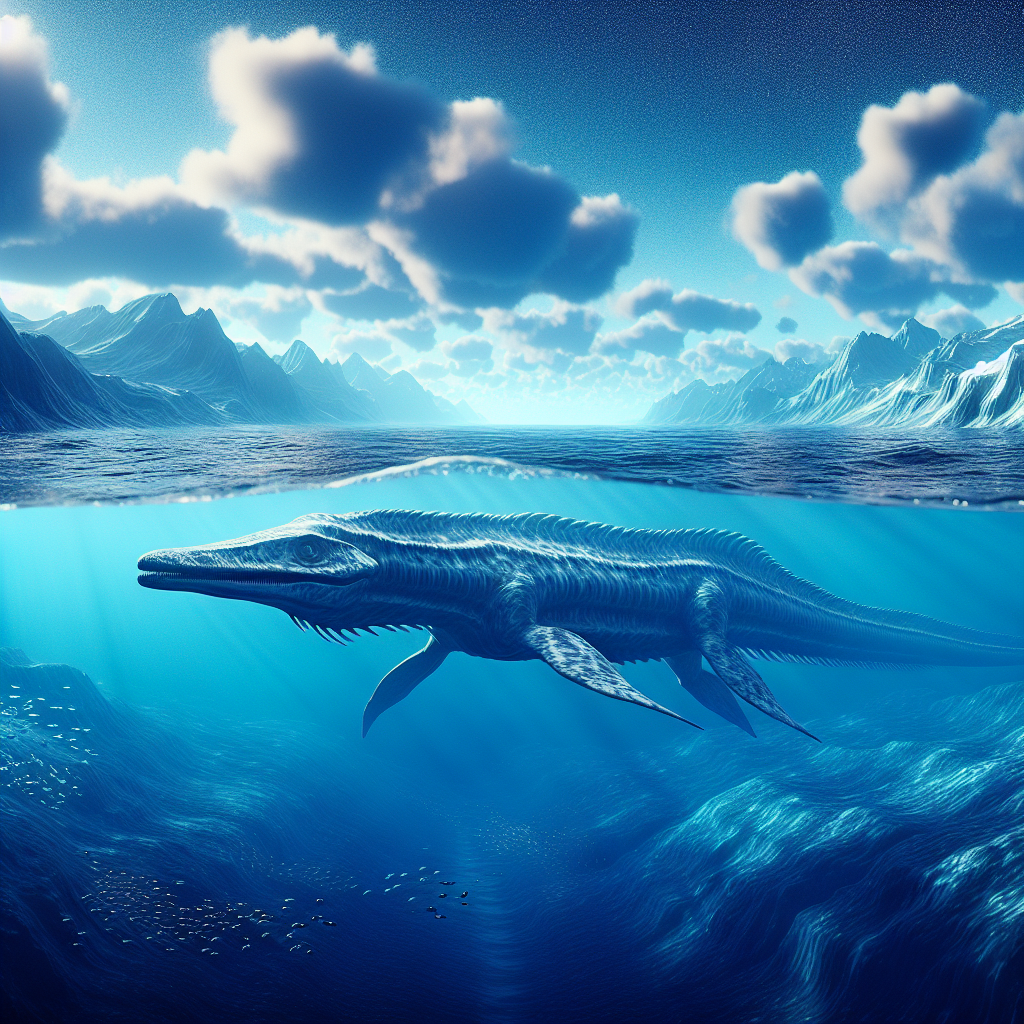Scientists have identified the largest marine reptile ever known to have existed. This enormous creature, which lived approximately 202 million years ago, was longer than two buses placed nose-to-nose. The fossilized jawbone of this reptile was discovered in 2016 by a fossil hunter on a beach in Somerset, UK. In 2020, another similar jawbone was found by a father and daughter. Experts believe that these fossils belong to two giant ichthyosaur reptiles, which could have been as long as 25 meters. This is larger than a pliosaur, whose skull was found in Dorset cliffs and featured in a David Attenborough documentary.
Dr. Dean Lomax, a paleontologist at the University of Bristol, explains that the size of the jawbones, one of which measures over a meter long and the other 2 meters long, indicates that the entire animal would have been approximately 25 meters long, similar in size to a blue whale. However, more evidence, such as a complete skull and skeleton, is needed to confirm the exact size of the creature, as only a few fragments have been found so far. The giant ichthyosaur became extinct in a mass extinction event, and subsequent ichthyosaurs never reached such enormous sizes again.
The first glimpse of this creature came in 2016 when fossil hunter Paul de la Salle discovered the jawbone while searching Somerset beaches with his wife. When he shared his find with Dr. Dean Lomax, they suspected it could be a significant discovery. Their findings were published in 2018, but they desired more evidence to determine the creature’s size. In 2020, Justin and Ruby Reynolds found another jawbone 10 kilometers down the coast, confirming their suspicions.
The team, along with family members, continued to search for fragments of the second jawbone, with the last piece being found in 2022. This discovery provided further evidence to estimate the creature’s size. The scientists have now concluded that this enormous animal is a new species of ichthyosaur, which they have named Ichthyotitan severnensis, or giant fish lizard of the Severn. The specimen found by Paul de la Salle has been analyzed for three years and will soon be displayed at the Bristol Museum and Art Gallery.
This discovery highlights the importance of amateur fossil collectors. Dr. Dean Lomax emphasizes that anyone, regardless of expertise, can make amazing discoveries with patience and a keen eye. He believes that families and individuals from all walks of life can contribute to scientific knowledge in the field of paleontology.
Original news source: Prehistoric sea reptile ‘twice as long as bus’ (BBC)
🎧 Listen:
Slow
Normal
Fast
📖 Vocabulary:
| 1 | paleontologist | A scientist who studies fossils and ancient life forms |
| 2 | ichthyosaur | A type of large marine reptile that lived during the Mesozoic era |
| 3 | fossilized | Preserved remains or traces of ancient organisms |
| 4 | pliosaur | A type of large marine reptile with a short neck and large head |
| 5 | documentary | A non-fiction film or television program that provides a factual report on a particular subject |
| 6 | extinction | The state or process of a species, family, or larger group being or becoming extinct |
| 7 | glimpse | A brief or incomplete view or look |
| 8 | significant | Of great importance or consequence |
| 9 | specimen | An individual animal, plant, piece of a mineral, etc., used as an example of its species or type for scientific study or display |
| 10 | analyzed | Examined methodically and in detail |
| 11 | amateur | A person who engages in a pursuit, especially a sport or hobby, on an unpaid basis |
| 12 | expertise | Specialized knowledge or skills in a particular field |
| 13 | keen | Having or showing eagerness or enthusiasm |
| 14 | fragments | Small parts broken off or detached from a whole |
| 15 | paleontology | The branch of science concerned with fossil animals and plants |
Group or Classroom Activities
Warm-up Activities:
– News Summary
Instructions: Divide the class into pairs. Give each pair a few minutes to read the article. Then, ask each pair to summarize the main points of the article in a short news summary. They can take turns presenting their summaries to the class.
– Opinion Poll
Instructions: Create a list of questions related to the article, such as “Do you think amateur fossil collectors can contribute to scientific knowledge?” or “What do you think is the significance of this discovery?” Have the students walk around the class and ask their classmates these questions, recording their answers. Afterward, have a class discussion where students can share their opinions and discuss their responses.
– Sketch It
Instructions: Divide the class into small groups. Give each group a large sheet of paper and markers. Instruct the groups to work together to create a visual representation of the giant ichthyosaur based on the description in the article. Encourage them to be creative and use their imagination. After a set amount of time, have each group present their sketches and explain their artistic choices.
– Vocabulary Pictionary
Instructions: Create a list of vocabulary words from the article, such as “ichthyosaur,” “paleontologist,” or “extinct.” Divide the class into teams. Give each team a vocabulary word, and have them take turns sending one member to the front of the class to draw a visual representation of the word. The rest of the team must guess the word based on the drawing. The team that guesses correctly earns a point. Continue until all the words have been guessed, and the team with the most points wins.
– Future Predictions
Instructions: Ask the students to imagine that more fossils of the giant ichthyosaur are discovered in the future. In pairs or small groups, have them discuss and make predictions about what scientists might learn from these future discoveries. They can speculate on topics such as the creature’s behavior, habitat, or evolutionary history. Afterward, have each group share their predictions with the class, and facilitate a discussion on the different ideas presented.
🤔 Comprehension Questions:
1. What is the estimated length of the largest marine reptile ever discovered?
2. Where were the fossilized jawbones of this reptile found?
3. What evidence is needed to confirm the exact size of the creature?
4. How did the first jawbone discovery come about in 2016?
5. Who confirmed the suspicions about the significance of the jawbone discovery?
6. How did the second jawbone discovery in 2020 confirm the suspicions?
7. How long did it take for the team to find all the fragments of the second jawbone?
8. What is the name of the new species of ichthyosaur that has been discovered?
Go to answers ⇩
🎧✍️ Listen and Fill in the Gaps:
Scientists have identified the largest marine reptile ever (1)______ to have existed. This enormous creature, which lived approximately 202 million years ago, was longer than two buses (2)______ nose-to-nose. The fossilized jawbone of this reptile was discovered in 2016 by a fossil (3)______ on a beach in Somerset, UK. In 2020, another similar jawbone was found by a father and daughter. Experts believe that these fossils belong to two giant ichthyosaur reptiles, which could have been as long as 25 meters. This is larger than a pliosaur, whose skull was found in Dorset (4)______ and featured in a David Attenborough documentary.
Dr. Dean Lomax, a paleontologist at the (5)______ of Bristol, explains that the size of the jawbones, one of which measures over a (6)______ long and the (7)______ 2 meters long, indicates that the (8)______ animal would have been approximately 25 meters long, similar in size to a blue whale. However, more evidence, such as a complete skull and skeleton, is needed to confirm the exact size of the creature, as only a few fragments have been found so far. The giant ichthyosaur became extinct in a mass extinction event, and subsequent ichthyosaurs never reached such enormous sizes again.
The first glimpse of this creature came in 2016 when fossil hunter Paul de la Salle (9)______ the jawbone while (10)______ing Somerset beaches with his wife. When he shared his find with Dr. Dean Lomax, they suspected it could be a significant discovery. Their findings were published in 2018, but they desired more evidence to determine the creature’s size. In 2020, (11)______ and Ruby Reynolds found another jawbone 10 kilometers down the coast, confirming their suspicions.
The team, along with family members, continued to search for fragments of the second jawbone, with the last piece being found in 2022. This discovery provided (12)______ evidence to estimate the creature’s size. The scientists have now concluded that this enormous animal is a new species of ichthyosaur, which they have named Ichthyotitan severnensis, or giant fish lizard of the (13)______. The specimen found by Paul de la Salle has been analyzed for three years and will soon be displayed at the Bristol Museum and Art Gallery.
This discovery highlights the (14)______ of amateur fossil collectors. Dr. Dean Lomax emphasizes that anyone, regardless of expertise, can make amazing discoveries with patience and a keen eye. He believes that families and individuals from all (15)______ of life can contribute to scientific knowledge in the (16)______ of paleontology.
Go to answers ⇩
💬 Discussion Questions:
Students can ask a partner these questions, or discuss them as a group.
1. What is an ichthyosaur?
2. How would you feel if you discovered a fossil of a new species?
3. Do you think there are still undiscovered species living in the ocean? Why or why not?
4. What do you think is the significance of this discovery?
5. How do you think the size of this marine reptile compares to other ancient creatures?
6. Do you think it is important for amateur fossil collectors to contribute to scientific knowledge? Why or why not?
7. How do you think the discovery of this new species could impact our understanding of prehistoric marine life?
8. What do you imagine it would be like to see a complete skeleton of this giant ichthyosaur?
9. Do you think there are still undiscovered fossils waiting to be found on beaches around the world? Why or why not?
10. How do you think the extinction of the giant ichthyosaur impacted the ocean ecosystem?
11. What other types of creatures do you think lived during the same time as the giant ichthyosaur?
12. How do you think the discovery of this new species could change the way we study and understand paleontology?
13. Do you think it’s important for museums to display fossils and other scientific discoveries? Why or why not?
14. How do you think the size of the giant ichthyosaur compares to modern-day marine animals?
15. What do you think motivated the fossil hunters to continue searching for more evidence of the giant ichthyosaur after their initial discovery?
Individual Activities
📖💭 Vocabulary Meanings:
Match each word to its meaning.
Words:
1. paleontologist
2. ichthyosaur
3. fossilized
4. pliosaur
5. documentary
6. extinction
7. glimpse
8. significant
9. specimen
10. analyzed
11. amateur
12. expertise
13. keen
14. fragments
15. paleontology
Meanings:
(A) Small parts broken off or detached from a whole
(B) An individual animal, plant, piece of a mineral, etc., used as an example of its species or type for scientific study or display
(C) Examined methodically and in detail
(D) A scientist who studies fossils and ancient life forms
(E) Preserved remains or traces of ancient organisms
(F) A person who engages in a pursuit, especially a sport or hobby, on an unpaid basis
(G) Specialized knowledge or skills in a particular field
(H) Having or showing eagerness or enthusiasm
(I) The state or process of a species, family, or larger group being or becoming extinct
(J) A brief or incomplete view or look
(K) A non-fiction film or television program that provides a factual report on a particular subject
(L) The branch of science concerned with fossil animals and plants
(M) Of great importance or consequence
(N) A type of large marine reptile with a short neck and large head
(O) A type of large marine reptile that lived during the Mesozoic era
Go to answers ⇩
🔡 Multiple Choice Questions:
1. When were the fossils of the giant ichthyosaur reptiles discovered?
(a) 2018 and 2022
(b) 2016 and 2020
(c) 2016 and 2018
(d) 2020 and 2022
2. What is the estimated length of the giant ichthyosaur reptiles?
(a) 10 meters
(b) 2 meters
(c) 1 meter
(d) 25 meters
3. What is the name of the new species of ichthyosaur discovered?
(a) Pliosaur dorsetensis
(b) Blue whale
(c) Giant fish lizard
(d) Ichthyotitan severnensis
4. What evidence is needed to confirm the exact size of the creature?
(a) Fossilized teeth
(b) Complete skull and skeleton
(c) Tail bones
(d) Claws
5. What is the role of amateur fossil collectors in this discovery?
(a) They analyzed the fossils
(b) They named the new species
(c) They made the initial discoveries
(d) They displayed the fossils
6. Where will the specimen found by Paul de la Salle be displayed?
(a) Bristol Museum and Art Gallery
(b) London Natural History Museum
(c) Somerset Fossil Museum
(d) University of Bristol Museum
7. When did the giant ichthyosaur become extinct?
(a) 2016
(b) 2020
(c) During a mass extinction event
(d) After the discovery of the fossils
8. What is the size comparison given for the giant ichthyosaur?
(a) Similar in size to a blue whale
(b) Longer than two buses placed nose-to-nose
(c) Larger than a pliosaur
(d) All of the above
Go to answers ⇩
🕵️ True or False Questions:
1. More evidence, such as a partial skull and skeleton, is needed to confirm the approximate size of the creature.
2. Scientists have identified the largest marine reptile ever known to have existed.
3. The scientists have named the new species of ichthyosaur Ichthyotitan severnensis, or giant fish lizard of the Severn.
4. Experts believe that the fossils belong to two small ichthyosaur reptiles, which could have been as short as 25 centimeters.
5. Another jawbone disproving the discovery was found in 2020 by a father and son.
6. The size of the jawbones indicates that the entire animal would have been around 2.5 meters long, much smaller than a blue whale.
7. The giant ichthyosaur became extinct in a mass extinction event, and subsequent ichthyosaurs never reached such enormous sizes again.
8. The fossilized jawbone of this reptile was discovered in 2016 by a fossil hunter on a beach in Somerset, UK.
Go to answers ⇩
📝 Write a Summary:
Write a summary of this news article in two sentences.
Check your writing now with the best free AI for English writing!
Writing Questions:
Answer the following questions. Write as much as you can for each answer.
Check your answers with our free English writing assistant!
1. What is the estimated size of the largest marine reptile ever discovered?
2. How were the jawbones of the giant ichthyosaur reptiles discovered?
3. What additional evidence is needed to confirm the exact size of the creature?
4. What is the name of the new species of ichthyosaur that has been discovered?
5. According to Dr. Dean Lomax, what is the significance of amateur fossil collectors in the field of paleontology?
✅ Answers
🤔✅ Comprehension Question Answers:
1. The estimated length of the largest marine reptile ever discovered is approximately 25 meters.
2. The fossilized jawbones of this reptile were found on beaches in Somerset, UK.
3. More evidence, such as a complete skull and skeleton, is needed to confirm the exact size of the creature.
4. The first jawbone discovery came about in 2016 when fossil hunter Paul de la Salle found it while searching Somerset beaches with his wife.
5. Dr. Dean Lomax confirmed the suspicions about the significance of the jawbone discovery.
6. The second jawbone discovery in 2020 confirmed the suspicions because it provided further evidence to estimate the creature’s size.
7. It took the team several years to find all the fragments of the second jawbone.
8. The new species of ichthyosaur that has been discovered is named Ichthyotitan severnensis, or giant fish lizard of the Severn.
Go back to questions ⇧
🎧✍️✅ Listen and Fill in the Gaps Answers:
(1) known
(2) placed
(3) hunter
(4) cliffs
(5) University
(6) meter
(7) other
(8) entire
(9) discovered
(10) search
(11) Justin
(12) further
(13) Severn
(14) importance
(15) walks
(16) field
Go back to questions ⇧
📖💭✅ Vocabulary Meanings Answers:
1. paleontologist
Answer: (D) A scientist who studies fossils and ancient life forms
2. ichthyosaur
Answer: (O) A type of large marine reptile that lived during the Mesozoic era
3. fossilized
Answer: (E) Preserved remains or traces of ancient organisms
4. pliosaur
Answer: (N) A type of large marine reptile with a short neck and large head
5. documentary
Answer: (K) A non-fiction film or television program that provides a factual report on a particular subject
6. extinction
Answer: (I) The state or process of a species, family, or larger group being or becoming extinct
7. glimpse
Answer: (J) A brief or incomplete view or look
8. significant
Answer: (M) Of great importance or consequence
9. specimen
Answer: (B) An individual animal, plant, piece of a mineral, etc., used as an example of its species or type for scientific study or display
10. analyzed
Answer: (C) Examined methodically and in detail
11. amateur
Answer: (F) A person who engages in a pursuit, especially a sport or hobby, on an unpaid basis
12. expertise
Answer: (G) Specialized knowledge or skills in a particular field
13. keen
Answer: (H) Having or showing eagerness or enthusiasm
14. fragments
Answer: (A) Small parts broken off or detached from a whole
15. paleontology
Answer: (L) The branch of science concerned with fossil animals and plants
Go back to questions ⇧
🔡✅ Multiple Choice Answers:
1. When were the fossils of the giant ichthyosaur reptiles discovered?
Answer: (b) 2016 and 2020
2. What is the estimated length of the giant ichthyosaur reptiles?
Answer: (d) 25 meters
3. What is the name of the new species of ichthyosaur discovered?
Answer: (d) Ichthyotitan severnensis
4. What evidence is needed to confirm the exact size of the creature?
Answer: (b) Complete skull and skeleton
5. What is the role of amateur fossil collectors in this discovery?
Answer: (c) They made the initial discoveries
6. Where will the specimen found by Paul de la Salle be displayed?
Answer: (a) Bristol Museum and Art Gallery
7. When did the giant ichthyosaur become extinct?
Answer: (c) During a mass extinction event
8. What is the size comparison given for the giant ichthyosaur?
Answer: (a) Similar in size to a blue whale
Go back to questions ⇧
🕵️✅ True or False Answers:
1. More evidence, such as a partial skull and skeleton, is needed to confirm the approximate size of the creature. (Answer: False)
2. Scientists have identified the largest marine reptile ever known to have existed. (Answer: True)
3. The scientists have named the new species of ichthyosaur Ichthyotitan severnensis, or giant fish lizard of the Severn. (Answer: True)
4. Experts believe that the fossils belong to two small ichthyosaur reptiles, which could have been as short as 25 centimeters. (Answer: False)
5. Another jawbone disproving the discovery was found in 2020 by a father and son. (Answer: False)
6. The size of the jawbones indicates that the entire animal would have been around 2.5 meters long, much smaller than a blue whale. (Answer: False)
7. The giant ichthyosaur became extinct in a mass extinction event, and subsequent ichthyosaurs never reached such enormous sizes again. (Answer: True)
8. The fossilized jawbone of this reptile was discovered in 2016 by a fossil hunter on a beach in Somerset, UK. (Answer: True)
Go back to questions ⇧













